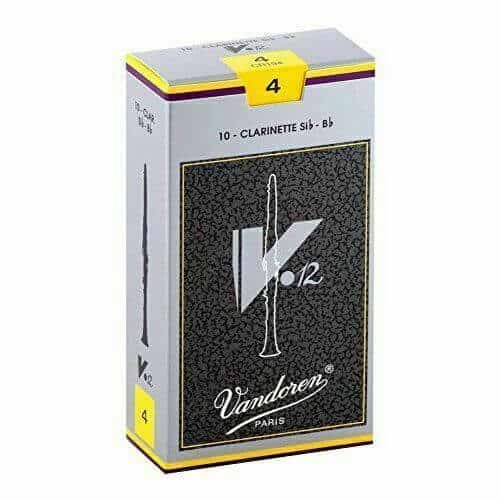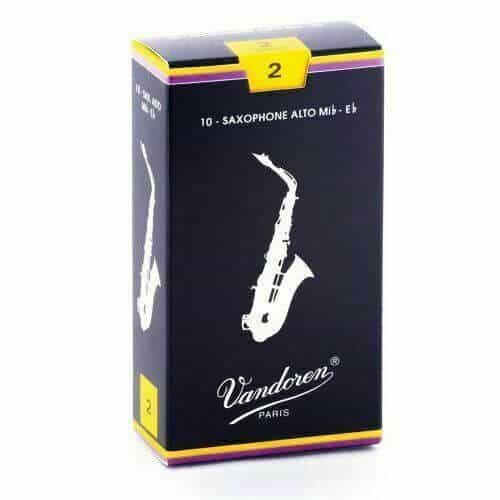While reeds aren’t that expensive and perhaps not the first thing you’d think of when you’re shopping for a sax, but they’re an essential one, nonetheless.
The vibration of the reed against the mouthpiece can make a huge difference in the way a horn sounds, especially when you’re trying to capture the difference between classical tones and jazzy ones.
So, between the Vandoren 12 vs. traditional Vandoren reed, which one should you opt for and why? Let’s explore what each has to offer in order to answer that question.
Table of Contents
Vandoren V12 vs. Traditional: Short Answer
The Vandoren V12 is an excellent classical reed that produces a warm sound, so it’s a great option for classic players. On the other hand, the traditional Vandoren reed is more versatile and allows you to experiment with plenty of genres, including jazz.
| Image | Product | Details | Price |
|---|---|---|---|
 |
Vandoren V12 | Best for Classic Players | Check Price |
 |
Vandoren Traditional | Best for a Wider Variety of Genres | Check Price |
The Full Comparison
Generally speaking, you shouldn’t worry too much about the reeds you try, as they’re not expensive and most importantly, they’re interchangeable. In this section, though, we go over the differences in order to help you choose the type of reed you should use to get started.
Construction
The traditional Vandoren reeds are also known as the Vandoren blue box, which is the color of the box they come in. They’re flexible and give you an excellent response, to the extent of enabling a saxophonist to hit the highest notes in pianissimo attacks. Vandoren’s “Flow Pack” seal keeps them fresh and ready to play.
The Vandoren V12 reeds are made of relatively thicker cane and thicker heel with a palette that extends longer to produce more vibrations. You can tell the lifespan of these reeds is over just a couple of weeks as the thicker tip makes them durable. Not to mention, they also come with a “Flow Pack” seal that maintains their freshness.
You can use either on an alto, soprano, and tenor saxophones.
Sound
The V12 sounds rich and deep, a perfect mix for classical music players. Thanks to the way it’s built, it gives you a dark sound that maintains evenness in all registers.
Traditional Vandoren reeds are super flexible instead of thick. That’s why they’re good with executions of staccato or legato and maintain a rich tone throughout large intervals. What this means for the sound is that it’s clear and full.
Their biggest advantage you get with blue box Vandoren reeds is that you can use them in whatever music setting you can think of, thanks to their versatility. This includes concert bands, jazz bands, orchestras, marching bands, or even rock bands.
Strengths
Both reeds come with plenty of strength options to give the player the softness or hardness they need, though the Vandoren blue box is a little more diverse.
The V12 comes in strength 2.5, 3, 3.5, and 4. On the other hand, the traditional comes with strength 1.5, 2, 2.5, 3, 3.5, 4, and 5. Not only that, but there’s a strength 2.5-10ct, 3-10ct, and a strength 3.5 that comes with mouthpiece cushions.
So, not only does it give more options for the strengths you can get to hit just the right amount of vibrations you want with accuracy, but it also provides luxury while doing so.
FAQs
What’s the Difference Between Hard and Soft Reeds?
Soft reeds give you brighter sound and more harmonics, and they’re definitely a lot easier to get a grip on. Generally speaking, they don’t require as much effort to play, which makes them more suitable for beginners and entry-level players than hard reeds.
On the other hand, hard reeds enable you to have more control over the airflow and result in deep, mellow sounds. They’re harder to manage, but they’re definitely worthwhile.
How Often Should Reeds Be Changed?
The lifespan of reeds varies among one type and another, but they could last as little as a couple of days and all the way to a couple of months. This depends on the quality of the reed and its thickness, but the maximum is six months for beginners that don’t practice and play their horn as frequently.
Conclusion
To sum up, if you’re looking for a stable tone and warm sound for classical playing, you should go for the Vandoren V12. On the other hand, if you want more versatility with all the registers and consistent sound for a wider variety of genres, you should definitely opt for the traditional, blue box Vandoren reed, especially that they come at a slightly more affordable price.

